October 2025

The biotechnology market size is forecasted to expand from USD 1744.83 billion in 2025 to USD 5036.46 billion by 2034, growing at a CAGR of 12.5% from 2025 to 2034, as a result of innovation and technological advancements in the biotechnology industry.
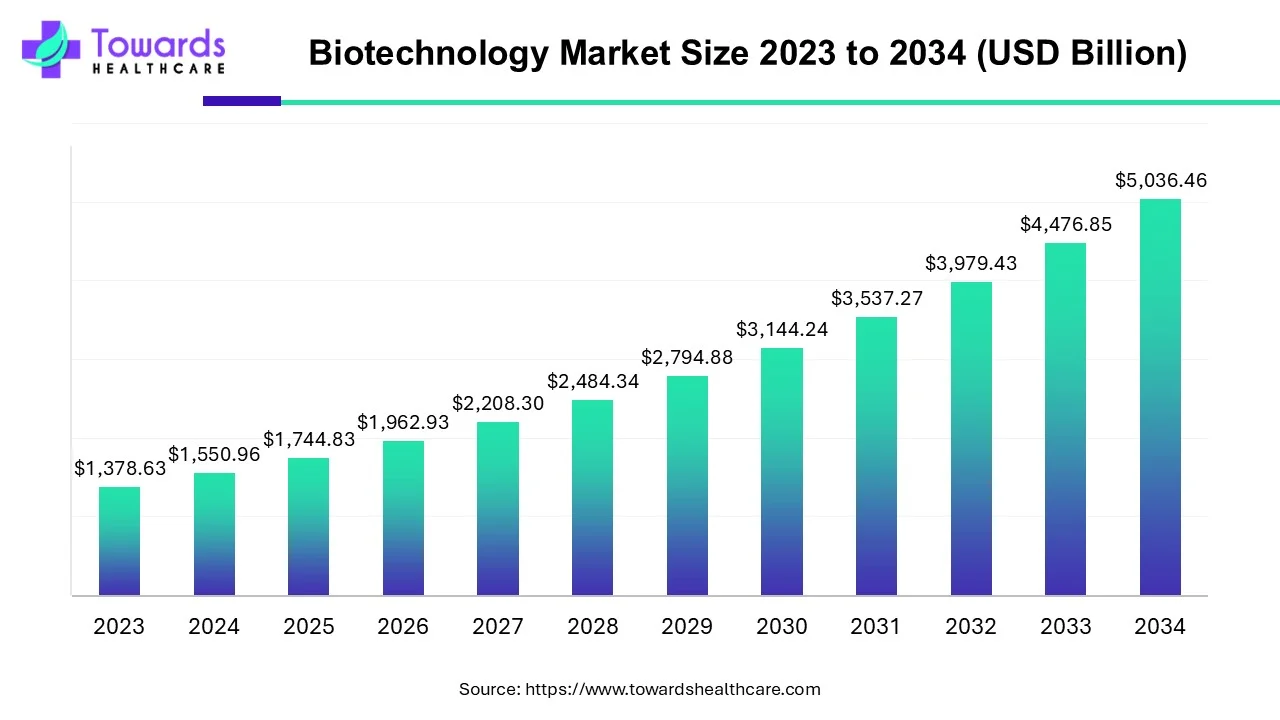
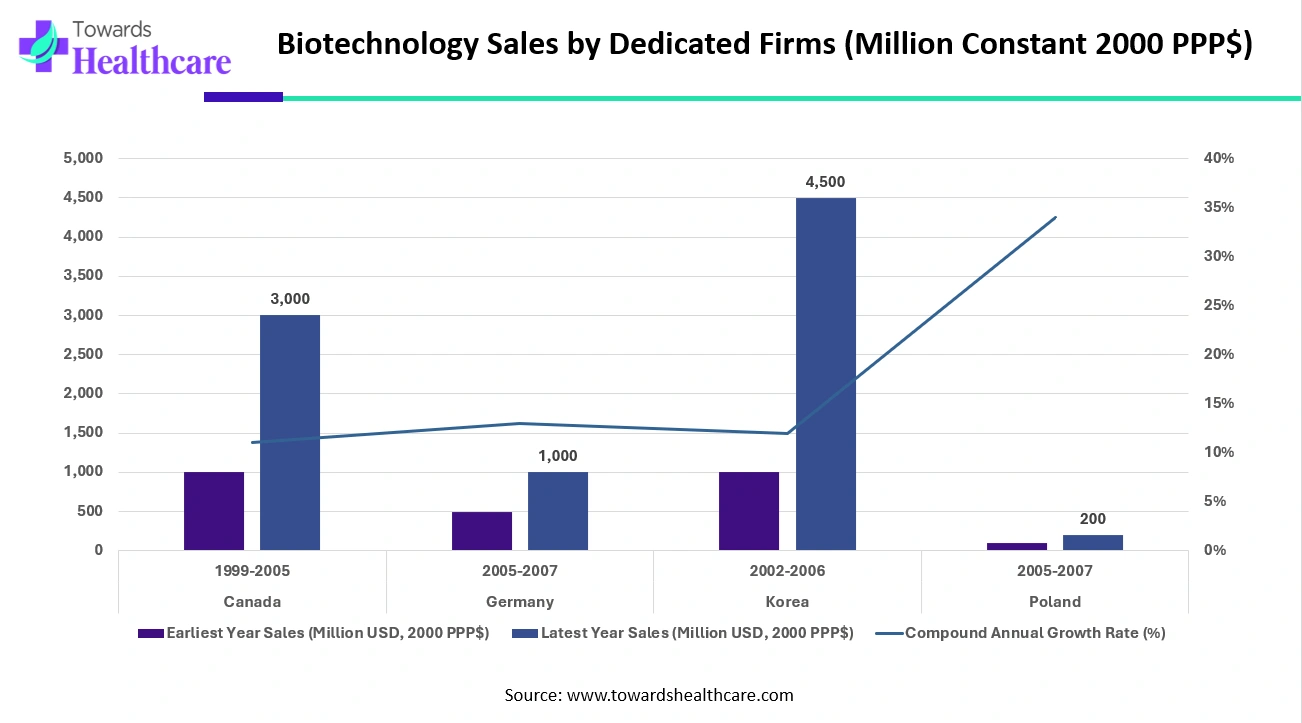
This chart illustrates the biotechnology sales of dedicated biotechnology firms in different countries over specific periods, adjusted to constant 2000 purchasing power parity (PPP) dollars. The data highlights both the sales growth and compound annual growth rate (CAGR) for each country.
The AI in biotechnology market is growing rapidly as artificial intelligence drives advanced predictive modeling, protein structure analysis, and automated laboratory workflows, enhancing research efficiency and fostering innovation. AI in biotechnology encompasses tools, platforms, and services that leverage machine learning, deep learning, graph neural networks, natural language processing, and generative models to tackle biological challenges from in-silico target identification, de novo molecule design, and single-cell analytics to clinical trial optimization, diagnostics, and biomanufacturing process management.
The AI in biotechnology market size reached US$ 3.27 billion in 2024 and is anticipate to increase to US$ 3.89 billion in 2025. By 2034, the market is forecasted to achieve a value of around US$ 18.76 billion, growing at a CAGR of 19.04%.
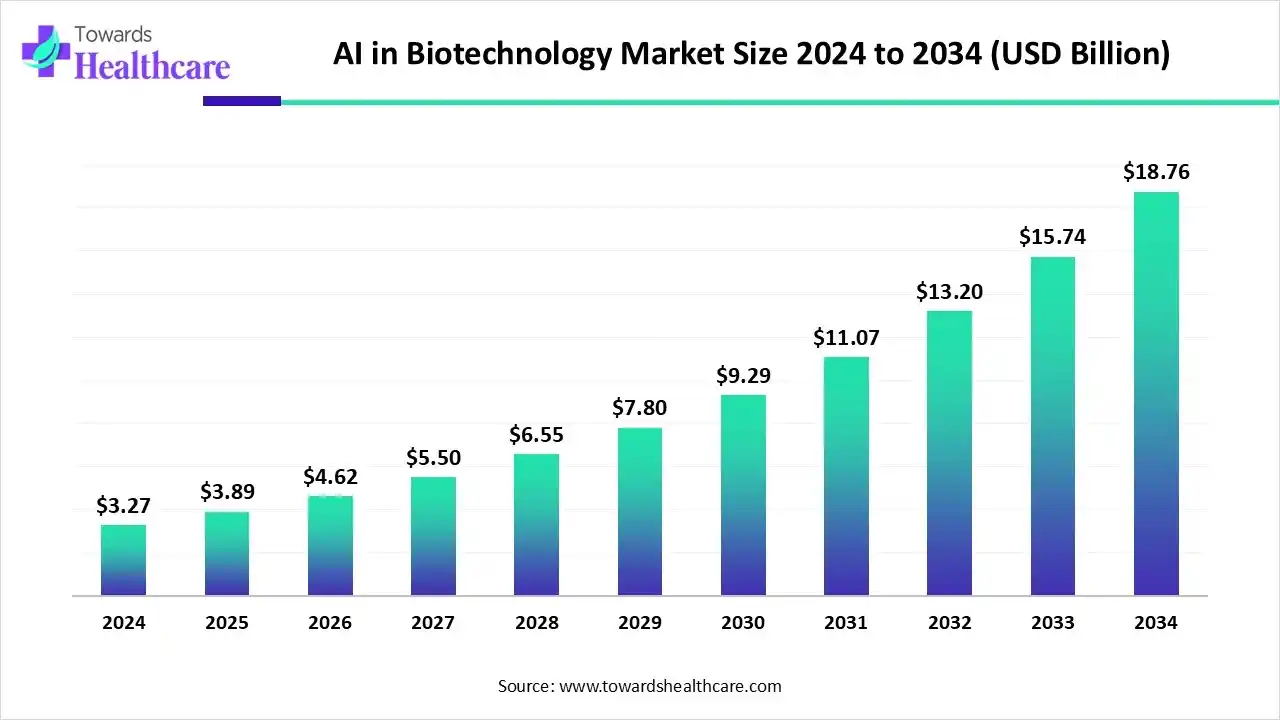
The global biotechnology market refers to the industry that uses living organisms or biological systems to develop new products, services, and technologies for healthcare, agriculture, industrial applications, and other fields. This market encompasses a wide range of sectors, including biopharmaceuticals, biotechnology research and development, bioprocessing, genomics, proteomics, bioinformatics, and synthetic biology.
The global biotechnology market has been growing rapidly in recent years, driven by a number of factors such as increasing demand for innovative treatments for chronic diseases, rising investments in research and development, advances in technology, and increasing government support. Biotechnology research and development often involves genetic engineering, gene editing, and other advanced techniques to modify or manipulate living organisms to produce desired traits or outcomes. Biotechnology has revolutionized many industries and has the potential to address some of the world’s most pressing challenges, such as disease, hunger, and climate change.
The biotechnology market is witnessing significant growth due to the increasing demand for food, the rising prevalence of chronic diseases, advancements in technology, and growing government initiatives to support biotechnology research. The market is expected to witness further growth during the forecast period driven by the biopharmaceuticals segment, DNA sequencing technology, and increasing investments in biotechnology research and development.
In 2024, approximately $26 billion was raised in venture capital rounds, compared to $23.3 billion in 2023. However, there were only 416 rounds compared to 462 rounds in 2023. The next waves of science and innovation are on the horizon, signaling that the bio-revolution is well underway.
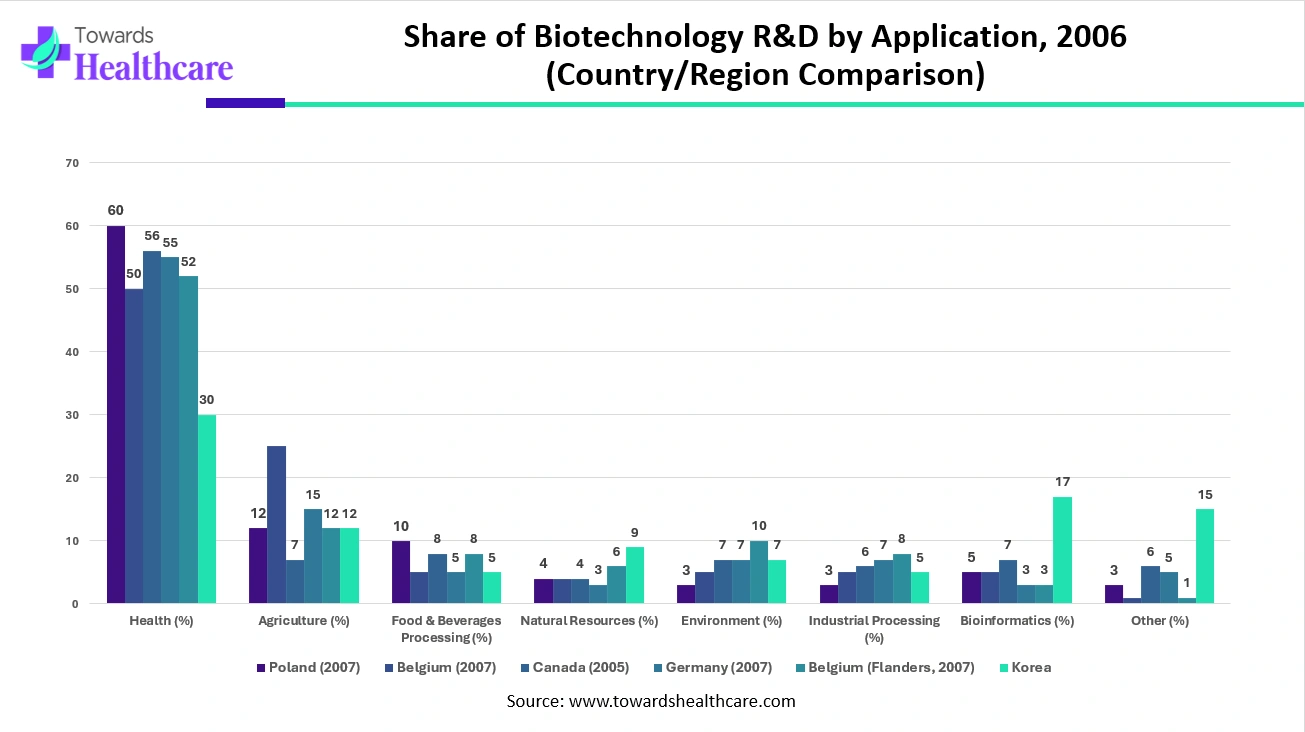
Explanation:
Biopharmaceuticals are drugs that are produced using biotechnology methods such as genetic engineering, fermentation, and cell culture. These drugs are developed using living cells, and they are designed to target specific proteins, cells, and genetic pathways. Biopharmaceuticals are used to treat a wide range of diseases, including cancer, autoimmune disorders, infectious diseases, and rare genetic disorders. The use of biopharma applications in biotechnology has had a significant impact on the development of new drugs and therapies.
In 2022, bio-pharmacy applications held around 41.46% revenue share in the global biotechnology market and are further projected to account for the fastest growth over the upcoming years.
Biopharmaceuticals have several advantages over traditional chemical drugs. They have high specificity and potency, which means they can target specific disease-causing cells or proteins more effectively. They also have fewer side effects and are less toxic to the body than traditional chemical drugs. Biopharmaceuticals can be produced in large quantities using cell culture techniques which makes them easier to manufacture than traditional chemical drugs. Additionally, biopharmaceuticals have a lower risk of contamination and are more stable than traditional chemical drugs.
The use of biopharma applications in biotechnology has led to the development of several successful drugs and therapies. One example is the use of monoclonal antibodies to treat cancer. Monoclonal antibodies are produced using biotechnology methods and are designed to target specific proteins on cancer cells. They have been successful in treating several types of cancer, including breast cancer, lymphoma, and leukemia.
Biopharmaceuticals are also being developed to treat rare genetic disorders, such as cystic fibrosis and hemophilia. These drugs are designed to replace or supplement a missing or defective protein in the body. The use of biotechnology methods to develop these drugs has led to significant advances in the treatment of rare genetic disorders.
The use of biopharma applications in biotechnology has had a significant impact on the development of new drugs and therapies. Biopharmaceuticals offer several advantages over traditional chemical drugs, including high specificity and potency, fewer side effects, and easier manufacturing. The success of biopharmaceuticals in treating a wide range of diseases has led to increased investment in biotechnology research and development.
Pharmaceutical products' use in personalized medical therapy is probably going to open up profitable business opportunities for market participants. In the upcoming years, it is anticipated that the prevalence of chronic diseases will rise, the biopharmaceutical industry will expand quickly, and healthcare spending will rise. A rich pipeline of innovative therapeutic substances and increased technology breakthroughs in the treatment of chronic diseases are also expected to boost the global market.
In addition, Research on stem cells, one of the revolutionary bio-pharmaceutical uses, is proceeding at an accelerated rate. Its main goal is to create highly customized treatments from the patient's own cells. Similarly, genetic engineering entails changing a patient's genetic makeup to identify specific regions of interest. The development of personalized medical care is being investigated, with biotechnology being incorporated. Businesses in the biotechnology industry now possess a competitive advantage attributable to the implications of cloud computing, artificial intelligence, and increased concentration on R&D. Furthermore, gene therapy, pharmacogenomics, genetic testing, and the development of biopharmaceuticals are the different applications of bio-pharmacy.
By technology, the DNA sequencing segment led the global market in 2024. DNA sequencing is a genetic engineering technology that is used to determine the sequence of nucleic acids. The rising incidences of chronic disorders such as cancer necessitate the use of DNA sequencing technology to identify significant genetic changes in tumor cells. This enables researchers to develop novel drugs or biologics based on such genetic changes. The growing demand for personalized medicines and technological advancements promote the segment’s growth. AI and ML can revolutionize the overall workflow of DNA sequencing, leading to accurate and precise outcomes.
By technology, the nanobiotechnology segment is predicted to witness significant growth in the market over the forecast period. Nanobiotechnology is a rapidly emerging field that uses special physicochemical and biological properties of nanostructures in medicine and other areas. Advancements in drug delivery systems and favorable regulatory frameworks contribute to the segment’s growth. Nano-drug delivery systems provide targeted therapeutic actions and fewer side effects. This technology also plays a vital role in the rapid detection of chronic disorders. The rising demand for point-of-care diagnostics potentiates the segment’s growth.
The North American biotechnology market was valued at USD 635.89 billion in 2024 and grew to USD 706.66 billion in 2025. It is projected to reach approximately USD 1,813.13 billion by 2034, expanding at a CAGR of 11.8% from 2025 to 2034.
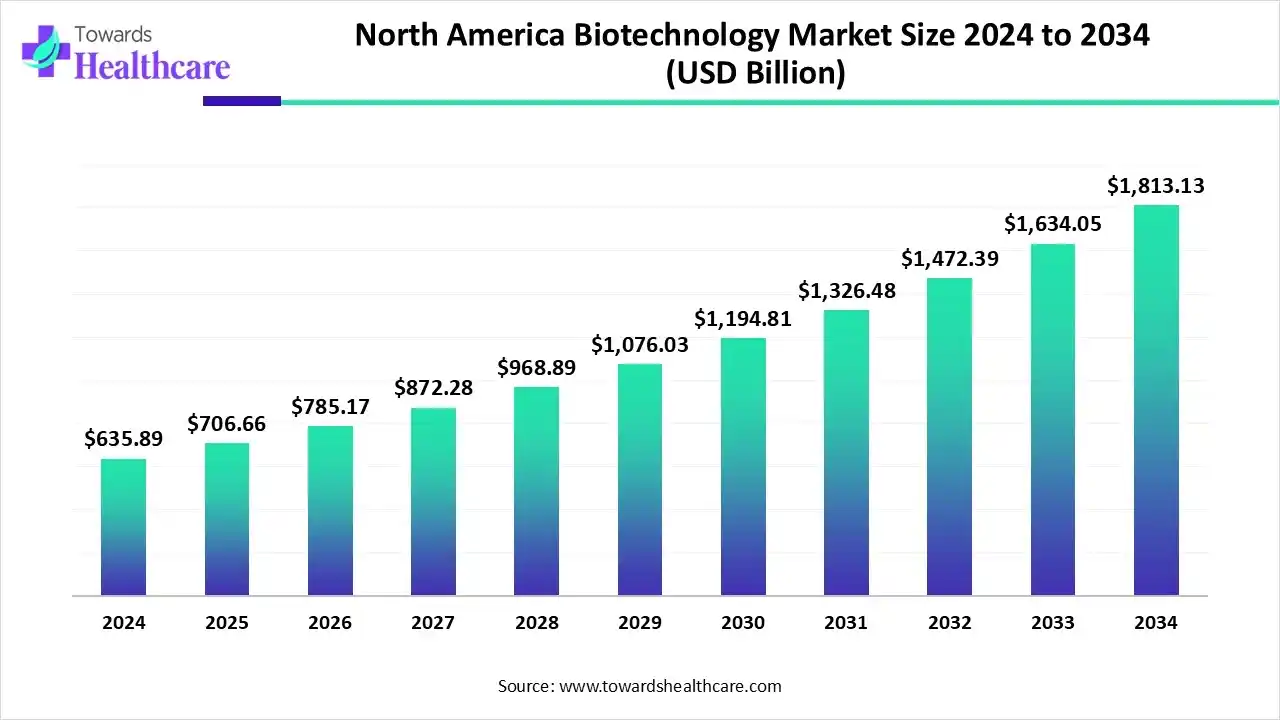
North America was the largest contributor to the global biotechnology market, with a 37.76% market share in 2022. However, the Asia Pacific will exhibit the fastest growth over the upcoming years. North America is a significant market for biotechnology, with the United States being the largest contributor to the region's growth. The North American biotechnology market is driven by the presence of a large number of pharmaceutical and biotech companies, as well as government support for research and development activities. Additionally, the region's move toward manual mechanization in the biotechnology, pharmaceutical, and related industries is driving demand for faster, easier-to-use equipment. Furthermore, Amgen Inc., CSL Ltd., Novo Nordisk A/S, Bristol-Myers Squibb Co., Merck & Co., Johnson & Johnson Services Inc., AstraZeneca PLC, and Pfizer Inc. are among the businesses that are helping North American biotechnology market growth.
The United States dominates the North American biotechnology market due to the presence of major players, a well-established regulatory framework, and a large patient pool. In 2022, the United States held a market share of around 47% in the North American biotechnology market. The growth of the biotechnology industry in the US is supported by increasing investment in research and development, favorable government policies, and the presence of leading academic and research institutions.
For instance,
The APAC biotechnology market is valued at US$ 372.23 billion in 2024 and is expected to grow to US$ 432.72 billion in 2025. Looking ahead, the market is projected to reach approximately US$ 1,611.67 billion by 2034, expanding at a CAGR of 14.8% between 2025 and 2034.

On the other hand, the Asia Pacific region is one of the fastest-growing markets in the global biotechnology industry with around a projected 22% of the market share in 2032. The region is witnessing an increasing demand for biotechnology products and services, owing to the growing prevalence of chronic diseases, increasing investments in R&D, and government initiatives to promote the biotechnology sector.
Countries such as China, Japan, India, South Korea, and Australia are the major players in the Asia-Pacific biotechnology market. China and India are expected to drive the growth of the market due to the presence of a large population base, increasing healthcare expenditure, and rising prevalence of chronic diseases. For instance, the Indian government allocated US$ 162.7 million to the Department of Biotechnology (DBT) in the Union Budget 2023-24 to support the advancement of research and development.
In recent years, the Asia Pacific biotechnology industry has witnessed significant developments, such as the establishment of biotechnology parks, partnerships, and collaborations between companies, and an increasing number of clinical trials.
The Europe biotechnology market is valued at US$ 418.76 billion in 2024 and is expected to grow to US$ 465.87 billion in 2025. Forecasts indicate the market could reach approximately US$ 1,208.75 billion by 2034, expanding at a CAGR of 11.30% between 2025 and 2034.
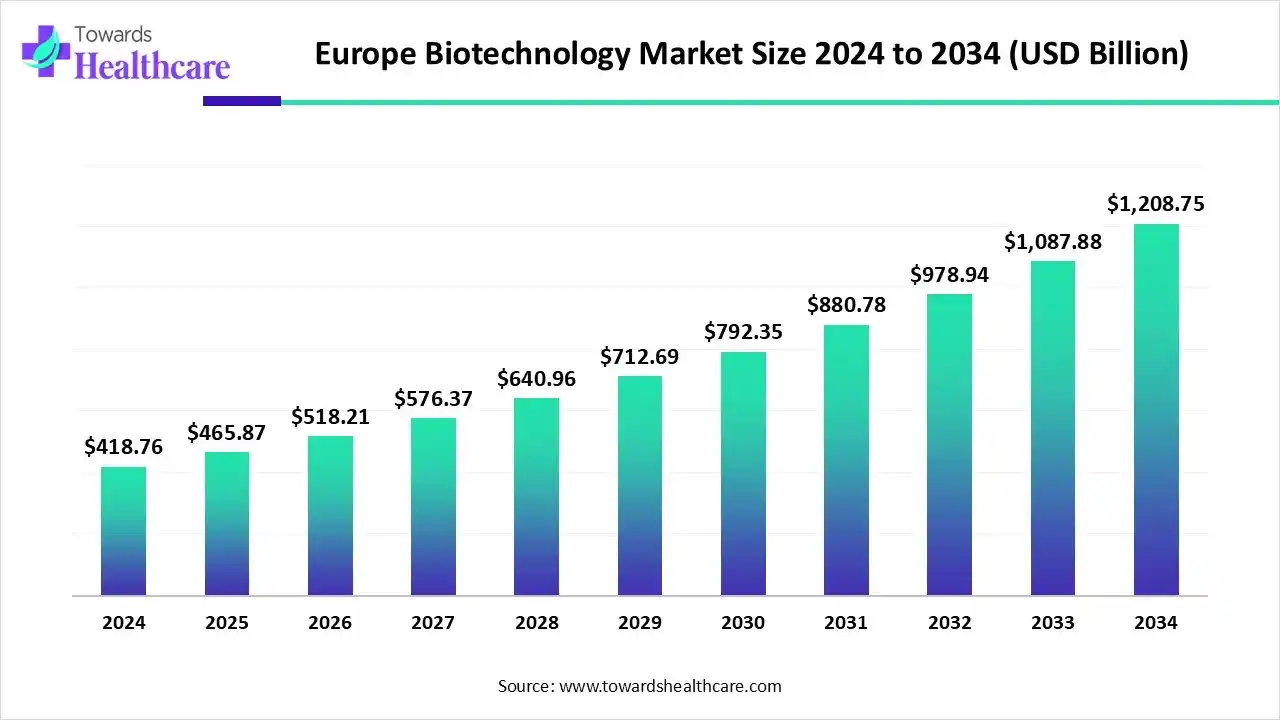
Europe is expected to experience significant growth in the biotechnology market during the forecast period. Various biotechnological industries in Europe are adapting to different technological advancements. At the same time, institutes are also developing various new diagnostic and treatment options, which are further supported by the government.
Germany Market Trends
The industries as well as institutes in Germany are developing new formulations as well as diagnostic approaches, which in turn are enhancing the market growth. To improve this development process, the support from the government is also provided.
UK Market Trends
Due to various technological advancements, the industries in the UK are evolving. Furthermore, the collaborations with the institutions are also improving the development process. At the same time, the rules and regulations of government and regulatory bodies also help in enhancing development with improved safety and affordability.
The Middle East and Africa biotechnology market was valued at US$ 46.53 billion in 2024 and is expected to reach US$ 51.47 billion in 2025, with projections indicating it could climb to approximately US$ 125.91 billion by 2034, growing at a CAGR of 10.80% over the forecast period.
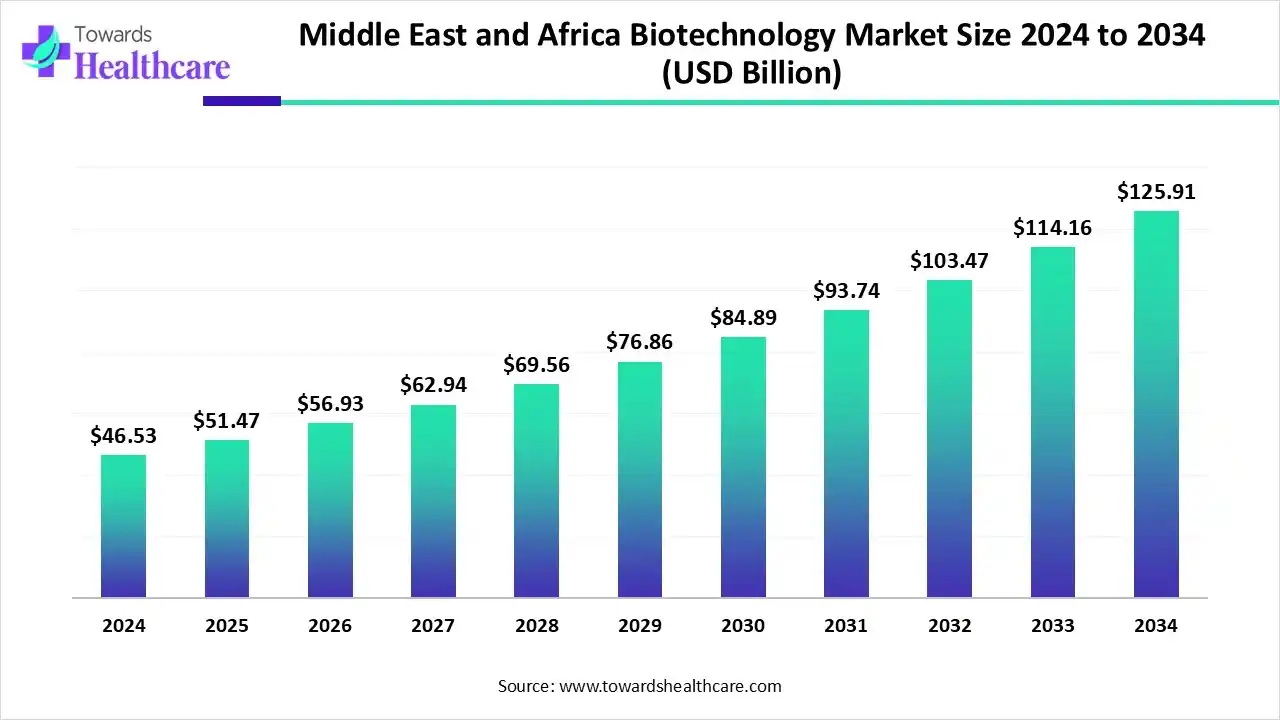
The Middle East and Africa are expected to grow significantly in the biotechnology market during the forecast period. The increasing incidence of diseases in the Middle East and Africa is increasing the demand for biotechnology solutions. At the same time, the increasing demand for accurate and early diagnostic approaches as well as effective treatment options is also contributing to the same. Moreover, the growing research and development in the industries and institutions is increasing the use of biotechnology solutions. They are being used in the development of targeted therapies and vaccines. This, in turn, is leading to collaborations among the companies. The demand for biotechnology solutions for agricultural purposes is also increasing. Thus, all these developments are supported by the government's initiative and investments. This, in turn, is promoting the market growth.
Saudi Arabia
To deal with the growing diseases, the demand for biotechnology solutions in Saudi Arabia is increasing. At the same time, increasing research and development for developing various diagnostic and treatment approaches is also contributing to this growth. At the same time, these developments are being supported by the government initiatives.
UAE
The demand for biotechnology solutions in the UAE is increasing for the development of advanced therapies, vaccines, personalized medications, etc. Moreover, the growing demand for biologics is increasing their production rates. Thus, the companies are collaborating to accelerate these developments. Furthermore, the government investments are supporting these developments, as well as helping the companies in utilizing advanced technologies and instruments.
The Latin America biotechnology market is valued at approximately US$ 77.55 billion in 2024 and is projected to grow to US$ 88.11 billion in 2025. By 2034, the market is expected to reach around US$ 277.01 billion, expanding at a CAGR of 13.10% from 2025 to 2034.
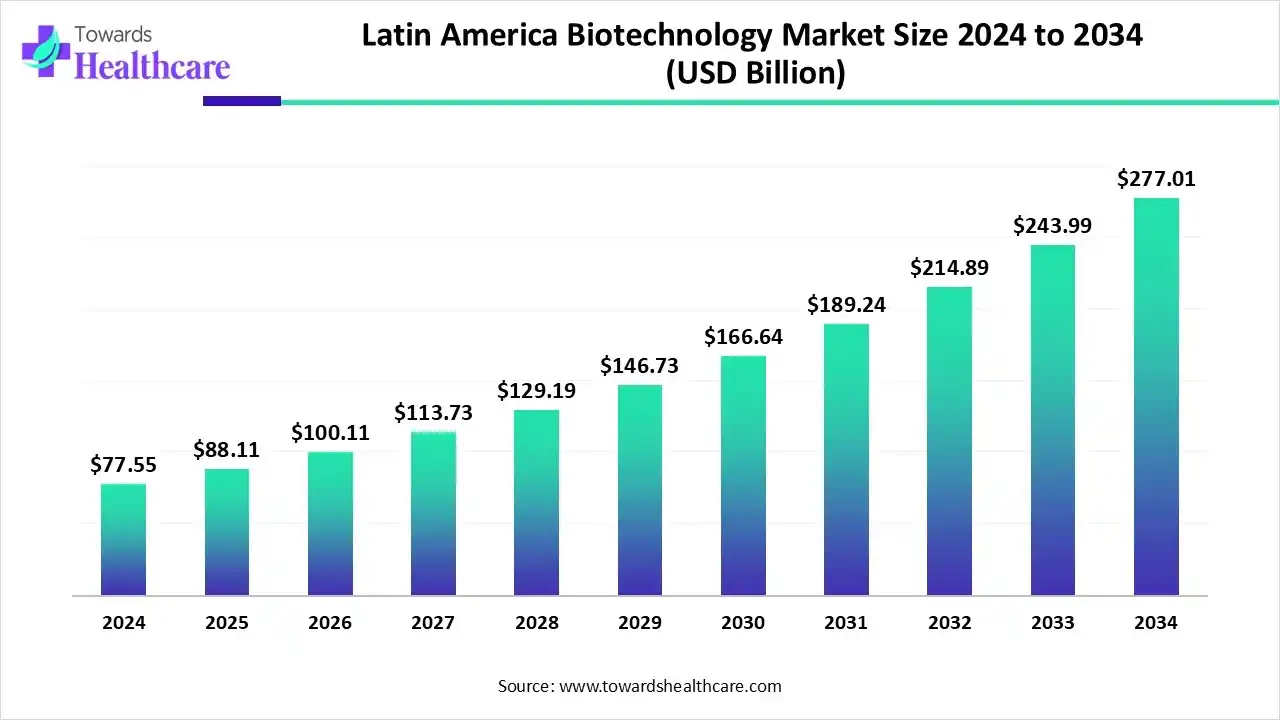
The Latin America biotechnology market is expanding due to increasing demand in healthcare and bioinformatics, rising R&D investments, the growing burden of chronic diseases, and a surge in precision medicine adoption. The aging population, rising healthcare needs, and focus on sustainable biotech solutions further drive growth, with Brazil leading the region supported by strong government initiatives.
With the rapid development of new technologies, such as CRISPR/Cas9 gene editing, synthetic biology, and gene therapy, the biotechnology industry is rapidly evolving and expanding. These technologies have enabled the development of new and innovative products, such as biopharmaceuticals and genetically modified organisms, that have the potential to revolutionize the healthcare and agriculture industries. Advances in biotechnology have led to the development of new and innovative products, such as biopharmaceuticals and genetically modified organisms. These products have revolutionized the healthcare and agricultural sectors, providing more efficient and effective solutions to longstanding problems.
In addition, technological advancements have improved the speed and accuracy of research and development in biotechnology. Tools such as genome sequencing and gene editing have allowed for more precise and targeted research, leading to the discovery of new treatments and therapies. For instance, one of the significant advancements is in genome sequencing and gene editing, which has allowed for more precise and targeted research. With the ability to decode the genetic makeup of organisms, scientists can identify genes responsible for various diseases and develop targeted treatments to combat them.
Furthermore, advancements in bioinformatics and data analytics have also contributed to the growth of the biotechnology market. With large amounts of data being generated from various sources, it is crucial to have tools and software to manage and analyze the data efficiently. Bioinformatics has made it possible to store, analyze, and interpret large amounts of biological data, allowing researchers to identify patterns and relationships that were previously impossible to detect.
The ability to decode genetic makeup and use the information to develop targeted treatments has revolutionized the healthcare industry, providing personalized and more efficient treatments to patients. The use of automation and high-throughput screening has also accelerated the drug development process, enabling faster identification of potential drug candidates. As technology continues to evolve, the biotechnology market is expected to grow and innovate further, providing solutions to address some of the most pressing challenges in healthcare, agriculture, and other industries. Moreover, technological advancements in high-throughput screening and automation have revolutionized drug discovery and development. With automated systems, researchers can process vast amounts of data and test potential drug candidates quickly and accurately, accelerating the drug development process.
The biotech industry has been facing a talent dilemma for several years now. As the industry continues to grow and expand, the demand for skilled professionals in various fields, such as research and development, manufacturing, quality control, and regulatory affairs, has also increased significantly. However, there is a shortage of skilled professionals to meet this demand, leading to a talent gap in the industry.
One of the reasons for the talent shortage in biotech is the lack of exposure to biotech education and training in schools and universities. Biotech is a relatively new field, and many educational institutions have not yet incorporated it into their curriculum. As a result, there is a shortage of graduates with the necessary skills and knowledge to work in the biotech industry.
Another reason for the talent shortage is the high demand for skilled professionals in other industries, such as technology and finance. These industries offer competitive salaries and benefits, making it difficult for biotech companies to attract and retain top talent. In addition, the biotech industry is highly regulated, which can deter some professionals from entering the field due to the perceived complexity and uncertainty of the regulatory environment.
In addition, the talent shortage in biotech has significant implications for the industry. It can lead to delays in the development of new treatments and therapies, as well as increased costs due to the need to outsource work to other countries or hire temporary staff. In addition, it can limit the growth potential of biotech companies, as they may not have the necessary resources to expand their operations or pursue new projects.
To address the talent dilemma in biotech, industry leaders and educators are taking steps to promote biotech education and training at all levels. This includes developing specialized courses and programs in biotech, as well as partnering with industry leaders to provide hands-on training and mentorship opportunities. In addition, biotech companies are offering competitive salaries and benefits to attract and retain top talent, as well as providing opportunities for career advancement and professional development.
Thus, the shortage of skilled professionals in biotech is a significant challenge for the industry. However, with concerted efforts from industry leaders, educators, and policymakers, it is possible to address this talent dilemma and ensure the continued growth and success of the biotech industry.
Personalized treatment options have indeed created exquisite growth opportunities for the biotechnology market. Personalized medicine involves developing therapies and treatments tailored to an individual patient's specific genetic and molecular makeup. It allows for more precise and effective treatment, reducing the risk of adverse side effects and improving patient outcomes. With advancements in technology and research, there is a growing understanding of the genetic and molecular basis of diseases. This has led to the development of targeted therapies and precision medicine, which aim to provide individualized treatment based on a patient’s specific genetic makeup and disease characteristics.
Additionally, there is a growing interest in regenerative medicine, which involves the use of stem cells and other advanced biologics to repair or replace damaged tissues and organs. This area of biotechnology has the potential to revolutionize the treatment of chronic diseases and injuries, such as heart disease, diabetes, and spinal cord injuries.
Furthermore, with the increasing availability of genetic and molecular data, personalized medicine is becoming more feasible and cost-effective. This has led to a significant increase in demand for personalized treatments, creating new opportunities for biotechnology companies to develop innovative products and therapies.
Moreover, personalized medicine has the potential to transform traditional healthcare practices, from prevention and diagnosis to treatment and management of diseases. It offers a shift from a one-size-fits-all approach to a more individualized and targeted approach, providing patients with better outcomes and quality of life.
The rise of personalized medicine is also driving the development of advanced technologies such as gene editing, CRISPR, and gene therapy, which are further driving growth in the biotechnology market. These technologies are enabling the development of innovative and targeted therapies, offering new treatment options for previously untreatable or difficult-to-treat diseases.
In addition to personalized medicine, the biotechnology market is also seeing a significant focus on the development of biosimilars, which are biologic products that are highly similar to already approved biologic drugs but at a lower cost. Biosimilars are increasingly being used to treat a variety of diseases, including cancer, autoimmune diseases, and diabetes, among others. The market for biosimilars is expected to grow significantly in the coming years, driven by increasing demand for cost-effective alternatives to expensive biologics.
Another trend in the biotechnology market is the growing focus on digital health solutions. Digital health technologies, such as telemedicine, wearable devices, and health apps, are being developed to improve patient outcomes and reduce healthcare costs. These technologies are also helping to drive personalized medicine, by enabling the collection and analysis of large amounts of data on individual patients.
Biotechnology and digital healthcare are two rapidly evolving fields that are intersecting to create innovative solutions for healthcare challenges. Biotechnology focuses on using living organisms and biological processes to develop products and technologies that can benefit human health, while digital healthcare involves the use of technology to improve the efficiency, accessibility, and quality of healthcare services.
One of the main ways biotechnology and digital healthcare are merging is through the development of digital health platforms and tools that integrate biological data with digital data to provide personalized healthcare solutions. For example, wearable devices that can monitor biometric data such as heart rate, blood pressure, and glucose levels, can be integrated with digital platforms to provide real-time data to healthcare professionals and patients. This data can be used to identify potential health issues and develop personalized treatment plans.
Another way biotechnology and digital healthcare are intersecting is through the use of artificial intelligence (AI) and machine learning algorithms to analyze large amounts of biological data and develop predictive models for disease diagnosis and treatment. AI can analyze complex biological data sets to identify patterns and relationships that may not be apparent to human researchers. This can lead to more accurate diagnoses and personalized treatment plans.
Biotechnology and digital healthcare are also collaborating to improve drug discovery and development. Digital platforms and tools can be used to process large amounts of data generated in the drug development process, making it more efficient and cost-effective. Biotechnology can be used to develop new drugs and therapies, while digital healthcare can be used to improve the delivery of these treatments to patients.
In January 2025, Flagship Pioneering announced a partnership agreement with Cambridge University Health Partners (CUHP) and the Milner Therapeutics Institute (MTI) to advance scientific research and technologies. Sir Tony Kouzarides, Director of MIT, commented that such research collaborations can propel the UK’s position as a hub for biotechnology innovation.
In July 2025, the H1 2025 reports were announced by Lonza, which noted the sale of CHF 3.6 billion with CER1 with 19% growth, while CHF 1.1 billion was noted for CORE EBITDA, achieving the margin of 29.6%. Moreover, the sale of CHF 3.1 billion with 23.1% CER growth and CHF 922 million CORE EBITDA was reported in the CDMO business, where the margin of 30.2% was noted. At the same time, the CDMO outlook for FY 2025, the CER sales are expected to rise around 20-21% and the margin of 30-31% for CORE EBITDA.
In February 2025, AstraZeneca released the financial performance for FY 2024. Sales-based milestones were achieved, as well as growth of partnered medicines was reported as the product sales showed a 19% rise along with a growth upto21% to $54,073m in total revenue. Moreover, the total revenue for Rare Disease was observed to be 16%, while for oncology it was 24%, V&I 8%, CVRM 20%, and R&I 25%. Additionally, a rise from 19% to $8.21 was projected for Core EPS. Furthermore, it was mentioned that the company is expecting a rise by a high single-digit percentage for total revenue and low double-digit percentage growth in Core EPS, both at CER.
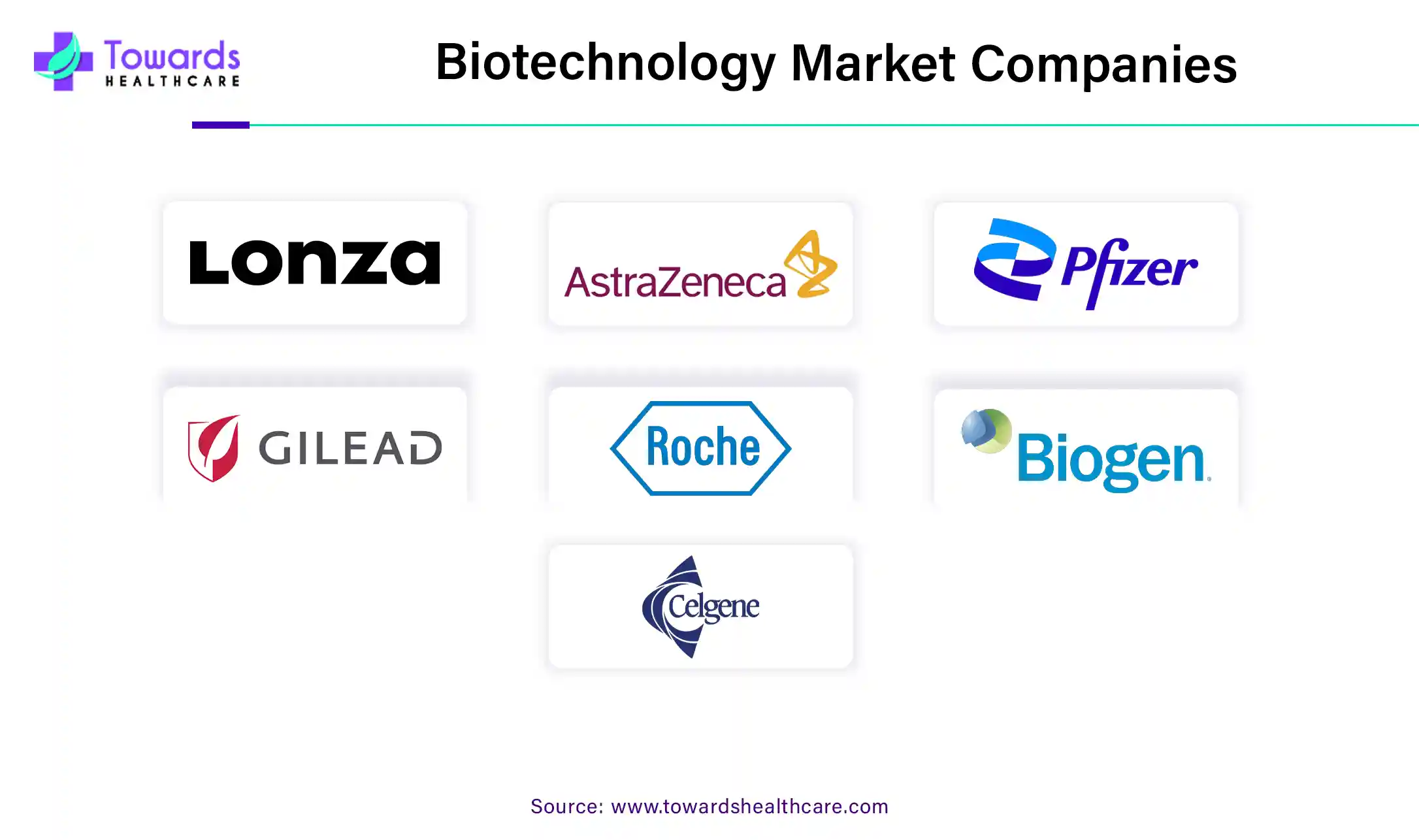
By Application
By Technology
By Geography
October 2025
October 2025
October 2025
October 2025